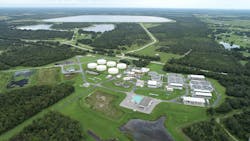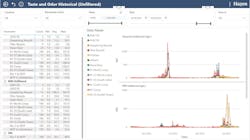Peace River Manasota Regional Water Supply Authority uses powdered activated carbon to ensure high quality drinking water
Background
Founded in 1982, Peace River Manasota Regional Water Supply Authority (PRMRWSA) supplies drinking water to a region of approximately one million people living south of Tampa Bay, FL in DeSoto, Charlotte, Sarasota and Manatee Counties. Its surface water treatment plant draws water from the Peace River to a reservoir and treats it to drinking water standards at the rate of about 31 million gallons a day.
Peace River Manasota Regional Water Supply Authority has won numerous awards, including the Florida Department of Environmental Protection’s 2023 Plant Operations Excellence Award, Florida Section AWWA 2023 Most Improved Water Treatment Plant, the Florida Section AWWA Outstanding Water Treatment Plant Award for 2021, 2018 and 2016, the Association of Metropolitan Water Agencies (AMWA) 2020 Sustainable Water Utility Management Award, and six AWWA Best of the Best Tap Water Taste Contest regional and state awards in Florida since 2004.
Taste and odor problems in drinking water are common in Florida
Florida’s rivers contain a high total organic content (TOC) due to the abundance of life that thrives in swamps, forests, wetlands, prairies and the state’s other diverse ecosystems. Runoff from these ecosystems results in surface water teeming with organisms. These life-forms create by-products that cause taste and odor events that are incompatible with the PRMRWSA high aesthetic standards for its finished drinking water delivered to the customer.
The organic compounds most often responsible for taste and odor problems in water are 2-methylisoborneol (MIB) and Geosmin. MIB has a musty smell and is most often produced in biofilm developing on rocks, aquatic plants and sediment. Geosmin has an earthy smell and is typically produced by planktonic cyanobacteria (suspended in water). These compounds are detected by human olfactory cells at very low concentrations. According to the Water Quality Association, humans can detect geosmin in concentrations as low as 10 parts per billion (µg/L) and MIB as low as 5 parts per billion (µg/L).
Beyond the aesthetic problem for the consumer, bad taste and odor create public anxiety about the quality and safety of the water, which can damage public trust in the water utility.
Geosmin and MIB spikes demand immediate and accurate dosing
Peace River, like many water utilities, experiences temperature-driven spikes in MIB and Geosmin. The probability of MIB and Geosmin spikes increases when water temperatures rise above 75oF; however, individual spikes are difficult to predict and require a fast-dosing response upon measuring elevated levels. In the last few years MIB and Geosmin spikes have lasted longer, requiring a more consistent dosing plan. When using carbon for extended periods, plants can use a smaller amount of a higher performing product to achieve successful results.
Peace River is closely monitoring concentration levels of the raw influent as well as environmental conditions to develop a model that will improve forecasting. This includes a current year-long study with a wide variety of data points to narrow down the conditions under which spikes occur. To keep a close eye on MIB and Geosmin levels, the plant increased its sampling rate from once a month in the winter to as often as three times a week in the spring as water temperature rises, increasing the detectability of spikes.
Product quality has a direct impact on performance and cost
To mitigate the presence of MIB and Geosmin, Peace River uses powdered activated carbon (PAC) from Jacobi Carbons (AquaSorb CB1-MW). Through controlled and optimized dosing, Peace River decreases the taste and odor compounds to non-detectable levels, ensuring the production of high-quality drinking water that customers expect. Sourced directly from a manufacturer who has their own internal laboratory testing and tight quality control, this activated carbon has higher quality, consistency and delivery reliability than activated carbon bought through a supplier with less stringent capabilities.
To optimize their activated carbon dosing protocol, Peace River has invested in on-site testing equipment to provide near real-time data on water quality. This monitoring allows them to dose immediately, more accurately and cost effectively, because they can dose according to current levels of MIB and Geosmin present in the water, rather than estimated levels based on days-old samples sent off for testing.
Another way that Peace River ensures the powdered activated carbon used in the taste and odor treatment process is their PAC procurement process. Prior to 2017, the facility required the activated carbon media be AWWA B604 approved and NSF-61 certified. One parameter of this specification is a minimum 500 iodine level, which allowed lower quality products to compete with products of higher quality, and potentially be selected if priced competitively. One year, this resulted in the winning supplier delivering a low quality product that caused major maintenance and repair problems for operational staff during contaminant spikes due to high levels of impurities. Additionally, the product was ineffective at normal dosing rates resulting in greatly increased dosing levels to achieve the non-detectable levels of MIB and Geosmin the PRMRWSA targeted, thus wiping out the price savings.
Since 2017, the facility has awarded its activated carbon contract based on a combination of price and performance (plus minimum standards such as an iodine number of 800 and a specific pH range) to achieve the highest quality carbon at the best price. To ensure performance, Peace River sends supplier samples to an independent lab — along with 10 gallons of actual intake water from the Peace River, to closely simulate field conditions — for an unbiased blind sample report on how well each submitted carbon performs on their source water.
Results and key takeaways
Peace River has been highly satisfied with AquaSorb CB1-MW and has been able to decrease powdered activated carbon (PAC) dosage levels due to its high performance. In 2023, the plant had to dose up to 43ppm to address one very high spike. Having a high-quality product means that they can use less activated carbon to mitigate such spikes and is part of their risk management strategy.
Peace River has learned that buying directly from a manufacturer of high quality product maximizes reliability for both product quality control and product consistency. The activated carbon delivery schedule is also an important factor. During high season the plant will receive three tractor trailer loads per week. Currently, Peace River has limited surplus storage space, so on-time delivery is critical for supply management. Logistics are especially important considering Florida’s vulnerability to hurricanes, which can drastically impact the delivery of all treatment supplies. When seeking a carbon supplier, facilities should consider the vendor’s ability to adhere tightly to a delivery schedule that aligns with the plant’s needs.
The price-performance ratio of a product, rather than absolute price, should drive a municipality’s selection of PAC. If a low-priced product is also low quality, a plant can end up losing all expected savings through increased maintenance, repair, labor, required dosing and associated energy. Perhaps most damaging of all is the potential for customer complaints and concern about taste and odor.
By using high-quality activated carbon, Peace River minimizes reputational risk and reinforces trust among the million people the utility serves while delivering safe, award-winning drinking water.
About the Author
Jim Knepper
Jim Knepper is the president of Jacobi Carbons, Inc. With more than 25 years in sales and marketing in the chemicals and plastics industry, Jim has served companies ranging from Fortune 100 to start up. He also worked two years as an environmental engineer specializing in waste reduction. Jim holds a chemical engineering degree from Virginia Tech and can be reached at [email protected].


